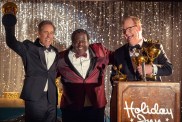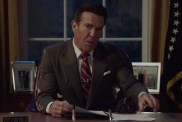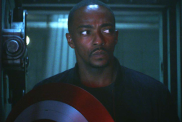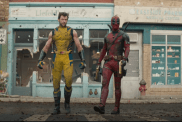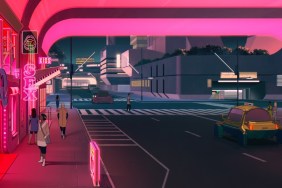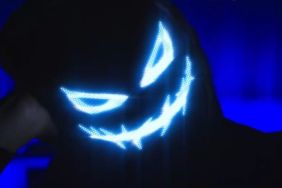Visiting the New Orleans set of Death’s fourth design

Hopefully, everyone has their special 3D glasses ready so they can read this set visit report in its full 3D glory, but if not, we’re also offering a special backwards-compatible 2D version for those who haven’t fully mastered the art of reading in 3D. The cause for this specially-enhanced Shock set visit is our foray to the heart of Louisiana for the latest chapter in New Line’s metaphysical horror franchise Final Destination 4.
ShockTillYouDrop.com just got back from New Orleans where we spent much of the day talking with our talkative, amicable tour guide, producer Craig Perry, who was fairly candid about everything from the 3D process to some of the things we’d see in the fourth movie, although everyone tried their best to keep as many as the deaths a secret as possible. We also met three of the new cast and talked briefly with David Ellis, returning to the series after helming Final Destination 2.
New Orleans was the location of a terrible American tragedy and a place that’s seen more than it’s fair share of death, so it would seem like the last place where you might find David R. Ellis filming the death-obsessed horror flick. It turns out that it was the least expensive places to film the most expensive installment of the series, which adds a fascinating new element by becoming the first live-action 3D horror film to be shot in High Definition on real locations (as opposed to being shot only on green screen stages). Shock’s benevolent older brother ComingSoon.net spent some time exploring the 3D Explosion when it comes to family and animated films, but with this trip, we were able see the process of filming using the newest 3D technology first-hand.
(Note: If you want to experience all the shocks and scares in this movie for yourself, you may want to stop reading here, as there are spoilers ahead! Oh, and if you’re a fan of Renny Harlin, you might not appreciate us bashing one of his “classics.”)
Many fans (myself included) might argue that the second movie was the best of the series, upping the ante for James Wong’s return for the follow-up in 2007’s Final Destination 3, but Ellis doesn’t feel competitive about upping the ante once again. “I’m not competing with James,” he admitted. “I think James is a good director and he’s got a totally different style that he’s done his movies in the Final Destination series and ours was different than his, so hopefully, the fans like them all. We definitely have to up the ante for the fans of the franchise, because they already know what the concept is obviously â you cheat death and get killed â and that’s pretty much what they’re coming to see is how are you going to kill them and is it going to be cool or not?”
“The decision wasn’t instant,” Perry admitted about returning for a fourth movie. “It was earned by the nature of the audience response and it was earned by virtue of the third one being successful enough to give us a shot to try. It was only by virtue of what Eric Bress did with the script that we were able to say that we were able to get everybody to say, ‘Hey, this is actually kind of fun’ and the merits of why this franchise has worked thus far became more and more to the point where New Line said, ‘Let’s go for it, let’s see if we can pull it together.'”

Ellis also played a large part in the decision to move the production from Vancouver down to the New Orleans area in hopes of bringing some much-needed business to the area, although the actual movie takes place in a similar suburban “Anytown” as the previous movies, rather than taking place in New Orleans. Since there were no actual soundstages in the city, they took over an immense warehouse that was previously used for the FOX drama K-Ville, as well as built a number of large-scale sets in various area locations.
The previous Final Destinations kicked off with a disaster that killed dozens of people but left a handful unscathed allowing Death to carry out its “grand design” later, picking each one of the survivors off in horrifying “accidents” that may have made them wish they had died in an airplane explosion or in a motorway pile-up or on a roller-coaster.
For the fourth movie, there are two big set pieces rather than just one, the first one being the catalyst for all of the bloody kills that follow, a devastating car crash at a racetrack, while the second big set piece is a deadly explosion at a movie theater that was being shot at the makeshift soundstage while we were visiting. Apparently, there’s a construction site behind this movie theater and something happens there that sets off a huge explosion that sends tools, nails and construction materials (cinderblocks and rebar) flying into the theater and invariably, into the poor trio of friends who thought that seeing a good movie might take their minds off of all the death and destruction they’ve witnessed.
Unfortunately, what they ended up seeing wasn’t exactly a good movie, and many around them up end up dying for it. We saw some of the movie being projected onto the movie screen and though Perry remained mum, it wasn’t hard to figure out it was a certain Renny Harlin action movie done for New Line starring Samuel L. Jackson and Geena Davis. It was chosen because it had a lot of action that can be used without showing the stars, which would require paying them on top of the movie’s regular cast and it was kinda cool to see how an explosion on-screen would coincide with the screen being blown out by the real blast.
The movie theater basically looks like your usual multiplex room when filled with patrons (which probably wasn’t the case when Long Kiss Goodnight played there) with popcorn and soda cups scattered throughout, and someone had actually devised a system to maintain continuity between shots by placing various movie-going accoutrements on a long table with numbered spots, each which had a popcorn bag (announcing a fictitious upcoming movie called Till Death Do We Part) and/or a soda cup for the appropriate extra to be holding when they entered the theater. We saw a long line of TRL-looking extras lining up to shoot a pre-explosion scene, and other extras and stuntmen were casually wandering around the set with severe facial burns, one guy’s eye was hanging from his face while another looked like Pinhead from Hellraiser having taken a box of flying nails to his head. (See, kids? That’s what happens when you go to see a Renny Harlin movie. Let that be a lesson to you.)
Before we left for the day, we saw them shooting the movie screen explosion which is done in four different layers that will be compiled later: the first shows the audience watching the movie, then there’s the actual explosion with fire blasting out of the screen, another where giant mortars covered in green material shoot debris from behind the screen and then a shot of stuntmen on rigs being thrown around by the impact of the explosion. We couldn’t actually be anywhere near the soundstage when they did the actual explosion, but we sure as heck heard it while we were outside talking to Perry, and later, we watched as they shot off the mortar blasts of debris into the empty theater.
We didn’t have a chance to see any of the opening racetrack accident being shot, but we were given a pretty good taste what to expect when Perry showed us a couple photos from his laptop, including the McKinley Speedway grandstand that had been built on an enormous parking lot at a local beer distribution plant. Here’s where they shot the primary scenes of the spectators being killed when cars and car parts went flying into the stands to gruesome effect. (We were shown the “after” of one car that plowed into a spectator as well as the rigging used to send another car flying into a pillar, taking it out and literally causing the entire grandstand to collapse.)

Ellis mused that how he handled the freeway crash in the second movie is what made them think of him to direct the fourth installment, and Perry agreed. “I think you’ll find that the very things that David brought to the opening of Final Destination 2, he’s bringing times ten to the opening of this movie. While they both involve cars, it’s a different thing. Obviously, the opening is set at modified stock car race, but as opposed to being, ‘Oh, look at the cars, who’s going to be in pole position?” That’s just a function of what happens in the stands. I don’t drive race cars but I go to events, where I’m in the stands watching things happen and if I’m there, I’m thinking, ‘Is that restraining fence going to work if something hits it?’ Our particular stadium has an overhang and I’m like, ‘That doesn’t look too stable.’ It’s that feeling of being in a place where if something were to happen, egress is not easy. The exits they have to get out can be crowded and choked pretty quick, and what we’re positing is that things from the crash come into the stands, which takes advantage of the 3D but also puts you, when you’re surrounded by 8,000 other people, not able to move very fast, and I think that’s a fear that everybody can access, that’s something we can tap into.”
Instead of paying to fill the stands with thousands of extras, they were embellishing the cast and extras with CG spectators, and later in the month, they would pack up and move production to an actual raceway in Mobile, Alabama for a week of second-unit with actual race cars zooming around the track with special rigs that would allow the 3D camera system to be mounted on cars to shoot the race sequences at insanely high speeds.
As has been the case with the previous installments, Final Destination 4 has a whole new cast of young actors with Bobby Campo playing Nick, the lucky soul who gets the premonitions and visions that saves him and his friends, at least temporarily. Hottie Shantel Van Santen plays Laurie his girlfriend, and ultra-adorable newcomer Haley Webb plays her best friend Janet. There’s a fourth friend named Hunt, played by Nick Zano, who had already filmed his scenes, but the three we spoke to tried to keep fairly tight-lipped whether and how they died in the movie, which was understandable.
“There are so many cool ways that people die in all of the movies,” Shantel told us when asked whether the three of them were competitive about the ways they died. “I got really excited when I would read about things that would happen in premonitions that even they are heightened, but the ways that we all have to die are all so neat that I don’t necessarily think it’s a competition, we just all want to be there to support each other. ‘I want to be there that day. I want to see your head get cut off or see your leg disappear.’ Things like that. It’s more fun.”
“I disagree,” Haley interjected with a giggle. (Seriously, she really is very cute! Hands off her, Ryan Rotten!) “It’s cool to sort of compare and contrast and see what other people are doing, especially when we’re as close as we are to see how these two die…or not die, you never know, but it’s very cool.”
Perry, Ellis and cinematographer Glenn McPherson (Rambo) had a lot to tell us and show us about the process of filming in 3D using PACE Technologies’ system, which involves special 2-camera rigs where the information from each can be recorded and processed to change the “convergence” between the two cameras, which essentially decides how much of the 3D effect is translated to the viewer. Outside the movie theater set, there was an impressive set-up of nine to ten monitors that showed data from each of the camera rigs, which could be translated by the technicians from PACE. They could also view what the scenes would look like rendered into 3D by bringing tapes out to the PACE trailer which was set-up with the appropriate rendering gear to show the film’s dailies in 3D. What’s cool is that the converge, or amount of depth, can then be altered in the computers, although it does often involve changing things when it comes to the editing.
“We had looked into doing the third one in 3D,” Perry told us. “Which makes sense – ‘Final Destination 3D’ – but interestingly at the time, the technology was there to capture it, but there was very limited technology to exhibit it, so it didn’t seem to make sense to spend an enormous amount of money capturing something that we couldn’t really exploit for many years on end. The thing that made it work for us is that the 3D technology and the screens started to catch up with each other. We started to come to this nexus where it would make sense for us to do this movie in 3D.”

“Let’s be realistic, the ‘Final Destination’ movies, there’s a certain formula that works,” he continued. “I think the reason why it has worked for now up to four movies is that is at it’s core, there’s a really interesting central thesis that is a bit more existential than just a guy in a mask hacking people up. Don’t get me wrong, I love those movies, I’ve been watching them since I was a kid, but this particular notion I think can translate into a whole bunch of other realms. You can do it over and over as long as the characters are slightly different and react to that positing of what the after-life might or might not be and how integrated is that after-life into our world. I think that we lucked out on the first one by coming up with an interesting fulcrum that we can balance a lot of things on. That, married with the prospect of doing it in 3D, I think facilitated us coming up with a bunch of scenarios that were fresh, original and yet familiar.”
“Really interesting stuff,” Bobby Campo agreed about what he had seen already. “It’s really visually beautiful to watch and it’s just going to really accentuate the audience’s participation with what we’re going through. As far as acting goes, it doesn’t change too much except the HD forces you to never go off. Over the shoulder stuff, you can see everything, so you really can’t ever…even the extra that’s shooting way back over there can’t be screwing around because we’ll see it. If they’re smiling, 40 yards away, we can still see it.”
There are other differences to the fourth movie besides the 3D and the dual set pieces, for instance, there will be a lot more premonitions of deaths to come (and not to come, as it were), and Perry said that writer Eric Bress (another Final Destination 2 returnee) has incorporated a new way of showing death’s presence. He promises that the movie won’t be nearly as moody and “shoe-gazing” either. “If you survived something, you’re not going to have this angst-ridden hand-wringing mortality question,” he stated. “You’re going to be like ‘F*ckin A right! I made it!’ and yet, the next step to that is when all of a sudden, that notion that you escaped death and now it’s coming back after you, eroding away at that ‘I am completely free and I got off’ stuff, that’s one of the things that I think really helped this particular movie distinguish itself from the other movies as well. It’s tonally a little more on target for how kids are today and how people have been inured to violence and spectacle and injury. They’re more selfish, they’re like, ‘Look how cool that is!'” And it won’t just be the usual and obvious jerks, assholes and shallow teens, getting their just deserts either, as we were warned. Death won’t be nearly as selective and may start going after a few people we like in this movie as well.”
After we spoke with Perry and the actors, we were shown some edited but unfinished footage just to give us an idea what the 3D would look like. While this footage included a number of sublime scenes of the friends sitting in a bar talking and watching wall monitors, we also got a taste for the gory racetrack mayhem, presumably some being from Nick’s premonition. One car slams through the fence into some poor schmoe who probably thought he had pretty good seats, and outside the racetrack, a young woman, who is completely freaking out and yelling at the four friends, is decapitated when a spinning tire comes flying through the air from the racetrack. (This is probably going to look even more amazing when it’s finished with the ubiquitous blood and gore.) One of the first (and probably most deserved) kills is that of a racist mechanic at the race played by Justin Welborn (The Signal), who we saw getting dragged behind a tow truck before catching on fire. (Earlier, we saw a photo of dummy lookalikes of Wellborn and the actress playing his wife severed in half, which might have been their fate if not for Nick’s premonition.)

Some of the locations previewed by the footage include a scene at a mall where the two girls are pestered by a remote-controlled helicopter and racecar. We would learn later that the movie theater was located in this mall, that was completely abandoned before Ellis’ production team brought it back to life for the movie, spurring the local government to get a look at what the mall might look like if they cleaned and reopened it. The three kids were also seen entering a garage with lots of potential opportunities for gruesome deaths hinted at, leading to a scene of some guy getting smooshed against a fence by a runaway van. It’s quickly edited away to a poolside scene where Nick is being squirted by a pesky little kid who gets knocked off his water raft, followed by an impressive underwater scene of the same kid scooping up hoops at the bottom of the pool, which we were told played an important part later rather than just being a bit of eye candy to show-off what they could do with the 3D technology. (Apparently, they used some of the same cameras that James Cameron used for Aliens of the Deep and Ghosts of the Abyss to shoot these.)
There was also a scene of Haley Webb going through a car wash and running into some troubles there, though one could probably assume that this wasn’t her final fate, because Death wouldn’t be so cruel as to kill her, would it? The footage ended with a shot of a bloodied-up Krista Allen having a huge car engine dropped on her with the cute catchphrase, something like “Coming at You in 2009.” Ellis told us later that this footage was just to give us a taste for the movie and they hadn’t shown us the “good stuff” since none of the visual FX had been added yet. For instance, there’s apparently a death sequence in a beauty parlor, a location that Ellis brought to the mix.
Since we spoke with Perry for a good hour or more about the franchise, and he’s a really funny guy, we thought we’d wrap this set visit up with a few more tidbits from him, though we have even more stuff from him to share if you’re all nice.
We were really curious about the decision to keep the numbering in the titles of the sequels, something that was being shied away from in recent years by most studios due to the “fear of sequels”, but was particularly funny considering that the first movie was called “FINAL Destination.” “Part of it is ‘if it ain’t broke, don’t fix it’ and the other part of it is we did bone ourselves by calling it Final Destination,” he admitted. “Oddly enough, I think that when you see Final Destination 4, you’re already going, ‘C’mon!’, but what we’re trying to avoid is that there’s always been the debate of every movie since the first one is putting that colon, you know, DEATH ON PARADE!” or something. That’s always sort of been a struggle because you don’t want to do that but the studio is trying to mitigate the thing you’re talking about. But at this point, if they are already on board for seeing a ‘Final Destination’ movie, the ‘4’ doesn’t bother them; it just helps them keep track.” (By the way, if you have been reading this feature in 3D, that subtitle flew at your computer monitor making it even scarier.)

Even though this is a sequel, there won’t be any direct connections to the previous three movies besides the concept, and the fourth movie won’t spend a lot of time discussing the “rules of Death” introduced in the first two movies. “I think by having a fresh set of people coming into the thing, they don’t regurgitate the rules, they just throw out, ‘Well, maybe it’s this, maybe it’s this,’ then we see the rules come to life in action as opposed to discussion. What we want is for everybody to feel like they could at some point have the kind of premonition that each one of our characters in the four movies has had at the beginning. If you make it a rarified thing, I’m suddenly distanced from that possibility.”
And where might the future of Final Destination be going? Could there be smaller-budget direct-to-video movies like other horror franchises? “I would like to think that we’d have the opportunity to do those,” the producer said. “As much as the movies work because they deliver big grand-scale things, I think they’re also as effective in those small sequences when a guy is in his kitchen and shit’s going crazy around him. There is an economic model that would work should there be a desire to do them that we could take advantage of, but I’m just trying to make it through this one. I think there’s this way that we could deliver a nice fun suspenseful movie that doesn’t have the scale but has the impact that this one does.”
Thankfully, Perry wasn’t being serious when he threw a couple possible ideas for future installments at the mortified reporters: “Not that anyone would make this movie, but you can do Final Destination in the Old West. Why not? Death’s been back there, too, you can do it in Medieval Times, not that I’m ever going to do that. I’m just saying’…I don’t want to do Jason X! That’s just one of the things that’s interesting about the central idea of the movie.”
(Perry also confirmed that Tony Todd, who played the mortician Mr. Bludworth in the first two movies and was the star of the Candyman” series, won’t be involved with the fourth movie, as Shock reported last month.)
Hopefully, we’ll have more from our interviews with the cast and Ellis, and maybe even a few more of Craig Perry’s Greatest Quips, to run sometime in the next few weeks. Final Destination 4 will open sometime in 2009.







Source: Edward Douglas

